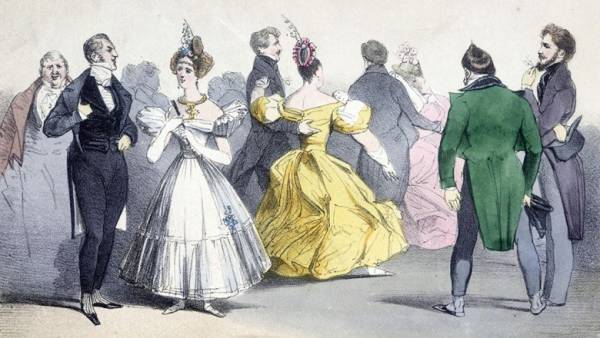The case of Mr. Bo. George Brummel: the man who taught men to dress
Millions of men, pokazyvaya in the morning, putting on a tie and business suit, most likely, don’t know who they have to thank for this, not changing (except, of course, the width of the lapels and the number of buttons on the jacket) for many generations uniform to go to work in the light, and indeed to the public. The name of Englishman George Brammel, received from his contemporaries the nickname Bo (from the French Beau, “pretty boy”), laid the foundations of the philosophy “dandyism,” and first formulated, how should look like a men’s suit — the order is forgotten.

The 240-th anniversary of the birth of the first revolutionary in the world of fashion portal iz.ru decided to recall the man once as famous as Byron and Napoleon.
To go for Prince
At the end of the XVIII century fashion — both male and female — was a phenomenon exclusively of the class; strictly speaking, existed only for the nobility, and the remaining strata of society dressed or according to professional status (the clergy and the bourgeoisie), or what will work (the peasantry and slowly appear, along with industry, the proletariat). Look fashion for men (women and their whims leave out of our story) like so:
Under a fur coat —vincerai Turukhansk wolf he was green, embroidered with gold and silk camisole, groenplein knickers buttoned below the knee with silver buckles, and striped, not across, rings, and silk stockings. In his hands he held a white clutch — “Manka”. It was all very fashionable and carefully considered.
Mark Aldanov in the “Bloody bridge” described the outfit young Russian court in 1796; the apparel of any European aristocrat of those times hardly differed substantially — except, most likely, was somewhat poorer.

Dictated by European fashion, naturally, the royals (as it was for centuries) — namely, Prince of Wales (future George IV) and the Comte d Artois (the future Charles X, the last of the elder line of the Bourbons on the French throne).
News As flirting men and women: the result of the survey
As flirting men and women: the result of the survey
This illustrious background, the fact that the trend setter was a native of the petty bourgeoisie (the elder Brummell was a man of relatively wealthy, but not “gentleman” and was anxious that the son managed to climb the social ladder), was a revolution — no less than raged in France. Helped the future of the chief dandies of Britain (then, however, the move was still a calque from the French “perimetr”) yet the familiarity with Prince George. In 1794, Brummell entered the service of the 10th Royal hussars, whose patron was the Prince. Soon the ambitious young man was promoted to Lieutenant, and George was so charmed by his impeccable manners, which allowed the young officer any liberties from mankirovaniya shifts, up to full absence for weeks. In 1796, thanks to the high patronage he was promoted to captain, and then retired the regiment was transferred to Manchester city, according to Brammel, uncivilized and uncultured.

The Brummel became the most fashionable socialite of London, by her father’s dream — thanks to the patronage of the Prince he was “an officer and a gentleman” received in the best houses. The main fashionista of the capital struck the public’s imagination with his cleanliness: he bathed several times a day, rubbing the body with a brush and liberally sprinkling themselves and the spirits were part of everyday life “water from Cologne.”
News 7 mistakes in personal hygiene, which you probably do
7 mistakes in personal hygiene, which you probably do
In an era when bath was still perceived more as a medical than hygiene, the procedure, and society ladies wore smeared with honey lockets-belogolovkin, such attention to cleanliness, many were shocked. Sprinkled with dust from flour wigs Brummel strongly rejected entering in Vogue men’s haircut in “Roman” style — whipped Kok and well maintained tanks. Every fold of his neckerchief was a work of art, to disturb the harmony which even a turn of the head would be, from the point of view Brammel, a crime. Told that at a dinner party he has held the following dialogue with stood behind him, a footman: “John, who is at my right hand?” — “With your permission, sir, that Marquis Headfort”. — “And on the left?” — “This is Lord Yarmouth”. — “Great!” — exclaimed Mr. Brummell (he never reached the summit of their dreams of belonging to the nobility, and remained simply a mister), who learned the names of the neighbors on the Board, and without turning his head, took their small talk.

But the most striking innovation was the new suit Brammel. He wore clothes made only from the best tailors and only irreproachable cut. But all the “stones”, brocade and gold men’s traditional attire was consigned them to the dustbin of history. Pushkin’s “trousers, tailcoat, vest” from the strict black or dark blue cloth, now become constant for all self-respecting men for centuries to come — even in its current variation trousers became pants, and tailcoat — jacket. The richness of its decoration is now contrasted with the refined cut and faultless material (usually finely crafted wool). And, of course, tie in those years used to be more a scarf, but quickly evolved to their current species.
When there is no money
Lifestyle Brammel cost him a lot of money. According to his own estimates that decently dressed man in his circle, you can do, “if approached with reasonable economy by £ 800” (about 62 thousand pounds at current prices; skilled workers received back in the year about 52 pounds). Although Brummel and received from his father a fairly decent inheritance, about 20 thousand pounds, on a familiar scale such funds lacked. Some time a guarantor on its debts was made by the crown Prince, but in 1813 between the former friends there was a fatal disagreement. Actually, the crack in the relationship appeared back in 1811 when George became Prince Regent (his father George III finally went mad and was declared incapable of performing the duties of the monarch) and began a more cautious approach to the choice of entourage.

Two years later, the first dandy, Britain was forced to flee from creditors in France — was said in the light, “1815 proved fatal for three great people: Brammel, Byron (the poet married. — iz.ru) and Napoleon”. This was followed by years of hardship and wandering, the French creditors has put Brammel in debtor’s prison, and he finished his days in 1840 in the asylum in Cannes — former “arbiter of elegance” damaged mind due to picked up in his youth of syphilis.
Remember, love
Brammel nevertheless not forgotten in the English-speaking world his name still is synonymous with impeccable style (albeit with a slightly mocking tone). In exile he wrote a book about his favorite subject with the intricate, as it was made the title:
Male and female costume; Greek and Roman costume, British costume from the Roman invasion until 1822 and the principles of costume applied to the improved dress of the present day.
The manuscript was discovered only in the twentieth century, the book was published and was reprinted several times. About him wrote Balzac and Conan Doyle, his image already in the twentieth century used in advertising, he became the hero of several movies (the latest, “This handsome Brummell”, was released in 2006). In 2002, the monument Brammelo established on Jermyn street in London.

But Brummell interesting today not only for its contribution to the history of costume. This London scatterbrain was ahead of its time more than two centuries — long before the invention not that of the Internet, but even the telephone and Telegraph, it became the prototype of the current stars of social networks. He was famous just because she was famous — like the current “influencers” of Instagram, his fame was based solely on itself, on the principle of “Domino effect”. Contemporaries imitated in the manner of dress and Lord Byron — but primarily because he was known to every educated man a poet, and then a great eccentric. Fashionistas wore boots “Wellington” and a la Souwaroff because the military glory of Suvorov Wellington and rattled for the whole of Europe. Suit Brammel copied just because he was the Brummel. “The greatest man of small mind, one of a kind,” as aptly described his contemporary, a classic of English literature William Hazlitt, who devoted Brammell one of his famous essays (“Bromelian”, 1828).